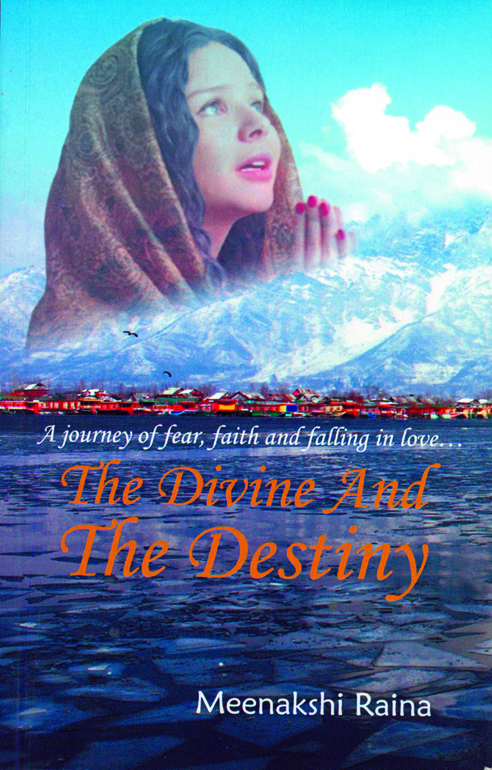Prof B L Kaul
The forced exodus of Kashmiri Pandits in 1990 from the land of their ancestors, in the wake of militancy aided and abetted by a hostile neighbourer inflicted painful wounds and left indelible marks of ghastly murders in the minds of members of the community. Just in a matter of days almost the entire population of unsuspecting peace loving community were uprooted and thrown out from their homes and hearths in harsh winter to live in exile in their own country. But for the generosity shown by the people of Jammu who threw open their homes to accommodate them, the community would have suffered immensely. The pain and anguish caused by the uprootedness is the main theme of ‘The Divine and the Destiny’ authoried by Meenakshi Raina. It is in two parts. In the first part the story revolves round Sheereen Kaul, the youngest daughter in the family of Professor Avtar Kaul, his wife Neena and their eldest daughter Simi and son Shivam. The family living in peace and tranquility in their home ‘Kaul Niavas’ built brick by brick by Professor Kaul and his wife with their hard earned money at Rambagh Srinagar are jolted one night when Rehan a neighbourer and friend knocks at their door.
Rehan advices them to leave Kashmir and save their lives. They hastily pick up some clothes and important documents. Rehan arranges a taxi to drop them at the bus stand so that they can go to Jammu. It is a bolt from the blue for the family. Enroute to the bus stand their taxi is stopped by militants and Professor Kaul is pulled out of the taxi at gunpoint. But for the intervention of a student turned militant he would be a dead man. This incident shakes the confidence of the whole family. At the bus stand there are many families braving the cold to board a bus for reaching Jammu safely. At Jammu there are initial difficulties of accommodation and to get registered as dsplaced persons.
The story woven artfully by Meenakshi depicting the tribulations suffered by the family of Shereen is praiseworthy for the simple reason that it is the story of all displaced families of Kashmiri Pandits. Her keen observation of the sufferings and mental agony caused by loss of dear ones, displacement and pain of uprootedness is quite obvious in her narrative. Even in the face of all difficulties and sufferings the community takes pains to educate their children. The narraive is simple, clear and effective. The vivid details given of the subhuman conditions in which the displaced people are made to live in the camps infested with snakes, scorpions and vermin are indeed moving.
As a story teller Meenakshi displays her gift and weaves the tale in an effective manner. She is able to portray the pangs of pain of belonging and loss of roots. Although it is her first novel yet she is able to make it interesting and absorbing. Besides portraying her characters in an manner which brings them alive, the dialogues are effective and the theme is good.
The second part of the novel deals with the love affair of Shereen and Aryan and the author is able to create a conflicting situation which is an important element of storytelling. She is torn between her family obligations and feelings for Aryan. Finally she is able to resolve the conflict and as the destiny intervenes, she marries Aryan and with the help of her sister and husband she is able to provide a home for her parents as well.
An important aspect that a reader cannot miss in the narrative is her success to make the reader relive the pain of the exiled Pandits. She has been able to treat fairly the subject namely forced exodus of Pandits- Seventh in the last six centuries beginning with Shah Mir’s rule in 1339. Despite the bitterness that displacement created in the minds of Kashmiri Pandits against Muslims she treats them fairly. She makes it clear in her narrative that not all Muslims of the Valley but only the separatists, hardcore elements and the fanatics wanted Pandits to leave. The fear psychosis that the militants had created prevented the majority of god Muslims to come to the rescue of their Hindu neighbourers and they advised them to leave the valley to save their lives.
Meenakshi has the talent to write true stories and give them the colour of fiction. The turbulent history of Kashmir is replete with themes on which a lot can be written, the forced exile of Pandits from their native land being the latest in the play of ‘The Divine and the Destiny’. As she succinctly makes it clear through depiction of her character Sheereen who says, ‘‘I always believe that it was the Divine power that saved the lives of innocent Kashmiri Pandits in the year 1990, when death was imminent. Perhaps it was their destiny to suffer for the sins committed by others, and they had been punished enough to be away from their homeland’’. And then there is optimism-‘‘I am confident that someday a new chapter would definitely be written in the history of Kashmiri Pandits which would talk about the end of their exile. That is destined to happen. A ray of hope would never end’’. I trust and hope that Meenakshi continues to write absorbing and interesting tales.


